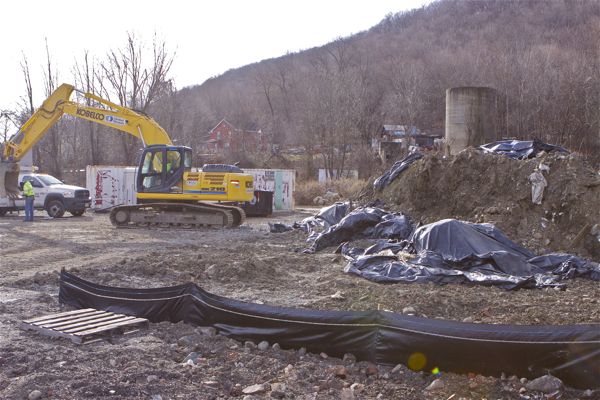Ford Ringwood Superfund Debate on Chemical 1,4, Dioxane Illustrates Flaws In Drinking Water Standards
Is the Pandora’s Box of “unregulated contaminants” finally opening?

This is what they don’t want you to see behind the fence – Ringwood Mines Superfund Site (Bill Wolfe, 1/3/12)
Scott Fallon of the Bergen Record has another good story today on the Ford Ringwood site– see:
Fallon is really getting into the weeds and listening to his primary source Michael Edelstein, a Ramapo College professor, and for that we say Bravo! – those interested in going deeper into the weeds, see page 5 of this EPA Technical Fact sheet.
EPA is fully aware of the lack of reliability regarding sampling and analytical methods for 1,4, Dioxane and simply has never publicly discussed that issue or taken steps to mandate that Ford use the most sensitive analytical methods.
That’s strike two for EPA, after failing to disclose the problem for almost a year after detecting the chemical in groundwater.
But Fallon buried the lead on the underlying source of the problem and does not explain the significant implications of the problem. That’s really strike 3 for EPA (again, a critical problem EPA rarely discusses publicly).
The underlying problem is that 1,4, dioxane – like over 500 chemicals found in NJ drinking water – is not regulated by EPA and there is no federal drinking water standard (“maximum contaminant level” – MCL) for 1,4, dioxane or any of those other 500+ chemicals millions of people drink every day!
[NJ DEP has a State enforceable “interim specific groundwater quality standard” (0.4 ppb) and “practical quantitation” limit” (PQL) (0.1 ppb) for 1,4, dioxane, but under the federal Superfund program, EPA is not required to comply with the state standards, but merely consider it as a “applicable and relevant” requirement. EPA made another mistake by not adopting NJ DEP’s ISGWQS and more sensitive PQL that would have required that Ford use more sensitive analytical methods – although the recent sampling by the Boro produced results even more sensitive than DEP’s PQL.
The Christie DEP should NEVER have approved and signed off on the EPA remedy without insisting that EPA enforce NJ DEP’s strict standard! The State of NJ concurred with the EPA approved Ford scheme (see Appendix V of the EPA ROD for the DEP State Concurrence letter).]
If 1,4, dioxane were regulated by federal EPA and there was an MCL established, there would be an EPA approved analytical method Ford would be required to use, Ford would be required to comply with the MCL in designing the site specific cleanup, there would be treatment required NATIONALLY to remove the chemical from drinking water, and there would be public disclosure of test results (if only via the Consumer Confidence and Source Water Protection program).
Here’s how the Bergen Record story explains that to readers – 9 paragraphs into a complex story:
A clear liquid used as a solvent and found in many products, including paint strippers, dyes and greases, 1,4-dioxane is considered an “emerging contaminant” by the EPA. The agency has yet to develop uniform health standards for 1,4-dioxane as it has for many hazardous substances, including others present at the Ringwood site. Still, several government agencies have said 1,4-dioxane is “reasonably anticipated to be a human carcinogen.”
Now that the Record has finally opened the can of worms on “unregulated contaminants” in drinking water, let’s hope they do followup stories that advise readers of the implications of that loophole.
Here’s a place to start – and here is a solution:
Trenton — New Jersey should filter its drinking water to remove hundreds of chemicals, most of which are unregulated, from its drinking water supply, according to a rulemaking petition filed today by Public Employees for Environmental Responsibility (PEER). The plan to screen many chemicals out of tap water was actually developed by the state Department of Environmental Protection (DEP) but has been in limbo for the last six years.
State testing has detected “approximately 600” chemical compounds “in 199 samples collected” including five brands of bottled water, according to a recent DEP white paper. The vast majority of these chemicals, including pharmaceuticals, hormones, and cleaning products, are not regulated by either the federal or state government. As a result, there is no regulatory effort to reduce or eliminate them from drinking water.
The April 2010 DEP white paper, entitled “Investigations Related to a ‘Treatment-Based’ Regulatory Approach to Address Unregulated Contaminants in Drinking Water,” advocates used granular activated carbon filtration and other techniques to remove most chemicals in drinking water, noting that carbon filtration alone removed more than half of identified chemicals.